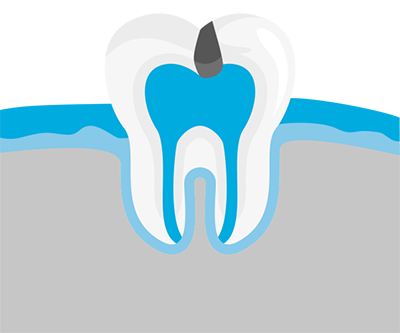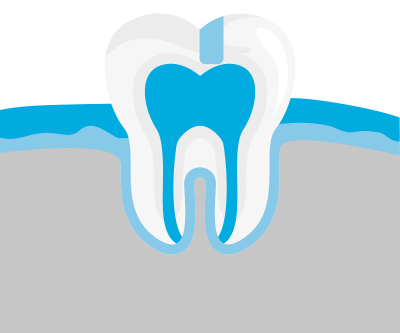How does caries develop?
Caries is a disease of the teeth caused by the metabolism of bacteria. It develops when the bacteria contained in plaque on the tooth convert sugar from food into acid over a longer period of time. The acid attacks the tooth enamel, the outer layer of the tooth and dissolves minerals from it. The tooth becomes soft and porous at this point, allowing the bacteria to penetrate deeper into the inside of the tooth until they finally reach the next layer, the dentin.


What can happen?
In naturally porous dentin, bacteria now spread at a greater rate. Holes in the tooth” are created when areas hollowed out by bacteria and acid collapse. If the caries gets close to the tooth nerve, toothache develops. The process of caries can lead to complete softening and dissolution and thus to the loss of a tooth.
What can we do for you?
The main goal is to prevent the development of caries. An early and regular clinical and radiological control supports this goal. Weak points in oral hygiene and possible other caries-triggering factors can be detected in time. If necessary, you can be integrated into our prophylaxis programme. It consists of regular tooth cleaning and instructions as well as motivation for proper oral hygiene.
If caries has already manifested itself, regular check-ups ensure that the caries is detected at an early stage and is therefore easy to treat. If a caries is discovered during the checkup, the therapy depends on the extent of the disease.
What can you expect?
Your therapy depends on the stage of caries and will be adequately adapted to it. If the disease is still in a very early stage, it is possible to wait and observe by optimising oral hygiene and fluoridation measures.
In some cases, the so-called caries infiltration is a treatment option, a method of sealing the caries without the need for drilling.
If the caries has already penetrated deeper into the tooth or into the dentin, a filling therapy is necessary. For the therapy, the tooth is isolated from the rest of the oral cavity with a rubber dam (rubber dam), which makes it easier to dry out the treatment area and keep an overview. In addition, no water collects in the oral cavity and is sucked out directly at the tooth. They can breathe and swallow normally under the rubber band.
On the picture the tooth is affected by a deep caries. It will be isolated for treatment with a rubber blanket.


The caries is removed and the edges are cleanlydisplayed, which makes the extent of the defect visible.
The defect is rebuilt with special systems and materials to give the tooth a natural shape and appearance.
If there has already been a very large loss of tooth substance, a laboratory-fabricated restoration may be necessary. In manchen Fällen wird auch eine root canal treatment will also have to be initiated.We will inform you in detail about the different options and materials, which always have to be weighed up individually.

What can you do?
Your therapy depends on the stage of the caries and will be adapted accordingly. If the disease is still in a very early stage, it is possible to wait and observe by optimising oral hygiene and fluoridation measures.
Regular check-ups at the dentist can detect caries at an early stage or even prevent it. Within the scope of professional tooth cleaning, your daily dental care is optimised and caries-causing bacterial plaque is effectively removed. Especially important is the cleaning of the interdental spaces with the help of dental floss or interdental brushes. Nutritional advice is also helpful. Food and drinks containing a lot of sugar and/or acid should be avoided.
You can reach us by phone on +352 290 022.
Opening times: Monday & Tuesday 8:00 a.m. – 6:00 p.m., Wednesday 8:00 a.m. – 2:00 p.m., Thursday 11:00 a.m. – 6:00 p.m., Friday 8:00 a.m. – 1:00 p.m.
Alternatively, you can also send us an email to kontakt@drjung.lu or an WhatsApp to +621 236 568
